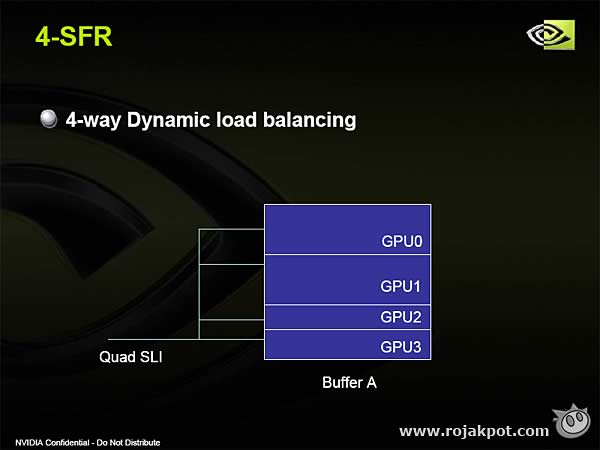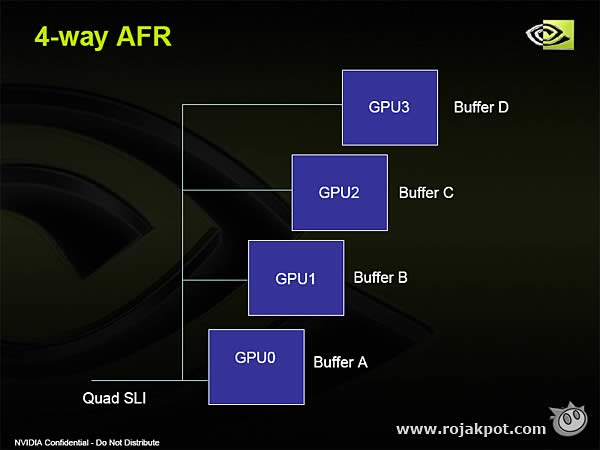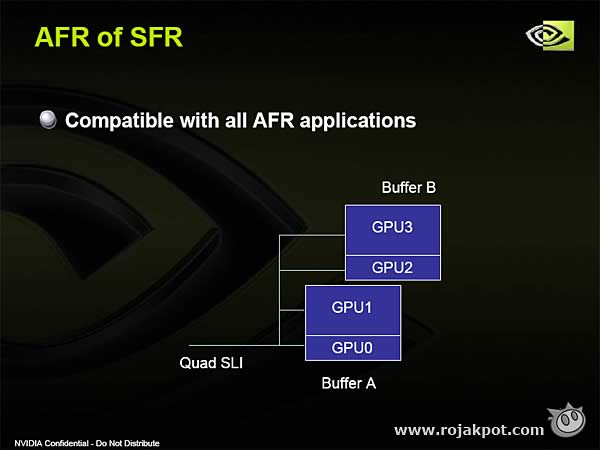New Rendering Methods
Quad SLI will support THREE new rendering modes :
- 4-way SFR (Split Frame Rendering)
- 4-way AFR (Alternate Frame Rendering)
- AFR of SFR
Confused? No need to be. We will explain what they are. First, let's take a look at rendering methods currently used by cards in SLI mode.
SLI Rendering
If you are running two cards in SLI, you can choose to either use Split Frame Rendering (SFR) or Alternate Frame Rendering (AFR). Here's how Split Frame Rendering works.

In SFR, every frame is split horizontally into two portions. Each portion is processed by one GPU and the final frame is sent to the framebuffer. The actual division of the frame is dynamically adjusted according to the load of the two GPUs and the complexity of the frame.
The second method is Alternate Frame Rendering, which is the preferred method because it is the most compatible mode.

In AFR, each frame is exclusively and sequentially processed by alternating GPUs. For example, GPU 1 will process Frame 1 while GPU 2 will process Frame 2. Once Frame 1 is completed and sent to the framebuffer, GPU 1 starts processing Frame 3. GPU 2 will finish processing Frame 2 and start on Frame 4. This goes on with each GPU processing different, alternating frames.
Quad SLI Rendering
Because Quad SLI involves four GPUs (naturally!), it offers a little more flexibility in rendering methods. As stated earlier, there are three Quad SLI rendering methods.
The first is 4-way SFR (Split Frame Rendering). Just like standard SFR, every frame is split up into four portions, each processed by its own GPU. Again, the split is dynamically adjusted, according to GPU load and scene complexity.

The second method is 4-way AFR (Alternate Frame Rendering). Here, every frame is processed by a different and sequentially alternating GPU. As the example below shows, every GPU processes a different frame.

So far, the two methods are mere extensions of SFR and AFR rendering methods in SLI. But with four GPUs to play with, an new rendering method is now possible.

As you can see, it's a hybrid of the SFR and AFR rendering methods. In this method, each frame is processed by TWO GPUs and the frames are alternated between two sets of two GPUs.
So, GPUs 0 and 1 will process Frame 1 while GPUs 2 and 3 will process Frame 2. Frame 3 will then be handled by the first set of GPUs 0 and 1, while Frame 4 will be processed by GPUs 2 and 3.
Again, each frame is dynamically split between the two GPUs, according to load and frame complexity.







 Add to Reddit
Add to Reddit
